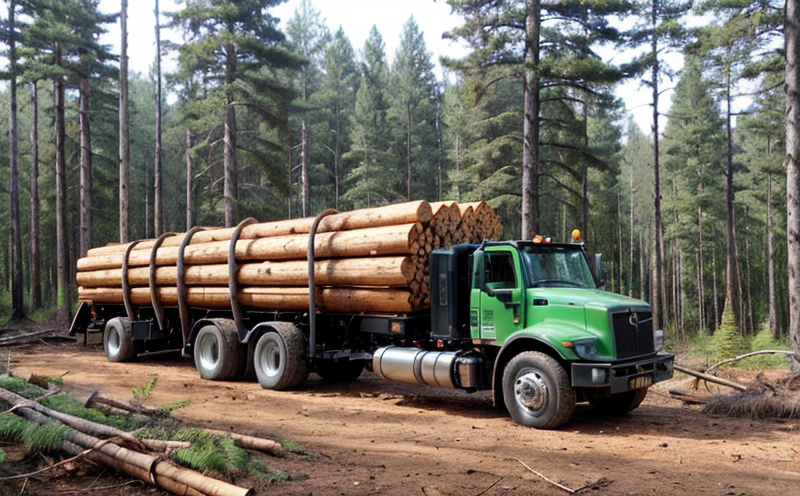Timber Shear Strength Testing
In the realm of agriculture and forestry testing, particularly within the category of forestry products testing, timber shear strength testing is a critical process. This service plays a pivotal role in ensuring the structural integrity and durability of wooden materials used in construction, furniture manufacturing, and other applications where wood quality is paramount.
Timber shear strength refers to the capacity of wood to resist shearing forces without breaking or deforming permanently. Understanding this property helps engineers and material scientists design products that can withstand various loads and stresses encountered during use. This testing is especially important for structures like floors, roofs, and beams where failure could have severe consequences.
The process involves subjecting a sample of wood to shear forces until it breaks or deforms significantly. The resulting data allows for the assessment of the material's strength, which can then be used in predictive modeling for future designs. For instance, knowing the shear strength helps in optimizing the design of components that will experience significant shear stress.
Proper specimen preparation is crucial for accurate testing results. Samples are typically cut from sound, defect-free wood and must be representative of the material being tested. Factors such as moisture content, age, and orientation can influence the shear strength, thus specimens should reflect these variables to ensure valid data.
The equipment used in this testing is sophisticated, designed specifically for measuring shear forces with precision. Commonly, a universal testing machine (UTM) equipped with appropriate fixtures is employed. The UTM applies controlled shear forces while sensors record the force and displacement, allowing for the calculation of shear stress at failure.
The results from this test are typically reported in units like megapascals (MPa), which provide a standardized measure that can be compared across different types of wood or samples. These data points help in making informed decisions about material selection and design optimization, thereby enhancing product performance and safety.
Scope and Methodology
| Parameter | Description |
|---|---|
| Sample Preparation | Specimens are cut from sound, defect-free wood and prepared to standard dimensions. |
| Testing Conditions | The test is conducted under controlled environmental conditions to ensure consistent results. |
| Force Application | Shear forces are applied gradually until the specimen fails. |
| Data Collection | The machine records force and displacement to calculate shear stress at failure. |
The methodology follows international standards such as ISO 14585, which provides detailed guidance on the test procedure. Compliance with these standards ensures that results are reliable and can be compared internationally. The process also involves quality checks at various stages to maintain accuracy and precision.
Once testing is complete, a comprehensive report is generated detailing all parameters tested, force-displacement curves, and calculated shear strengths. This detailed documentation supports decision-making processes in product development and compliance with regulatory requirements.
International Acceptance and Recognition
- ISO 14585: This international standard is widely recognized for its comprehensive approach to shear strength testing of wood products.
- ASTM D143: Another key standard that sets the benchmark for tensile, compressive, and shearing strengths in wood.
- EN 326: Provides additional European-specific standards for timber testing, including shear properties.
- IEC 62768-1: Focuses on the mechanical properties of structural elements made from wood or wood-based materials.
The acceptance and recognition of these tests are crucial in global markets. Compliance with these standards ensures that products meet international quality benchmarks, facilitating trade between countries with different regulatory frameworks. Many industries rely on these tests to ensure product consistency and reliability across borders.
Moreover, certification bodies often require compliance with such standards as part of their accreditation process for quality management systems. This adds an additional layer of assurance that the testing is conducted under rigorous protocols, enhancing trust in the results.
Competitive Advantage and Market Impact
Timber shear strength testing provides significant competitive advantages by ensuring product quality and reliability. In a market where wood products are increasingly demanded for sustainability reasons, understanding and demonstrating the structural integrity of these materials is crucial.
By utilizing advanced testing methods that adhere to international standards, companies can differentiate themselves in terms of product performance and durability. This not only enhances customer satisfaction but also opens up new markets by meeting stringent regulatory requirements. For R&D engineers, this service offers valuable insights into material behavior under stress, enabling innovation in wood-based products.
For quality managers and compliance officers, the ability to consistently meet these standards reduces risks associated with product failure and recall. It also supports sustainable sourcing practices, ensuring that only high-quality materials are used in production processes.
In the broader context of forestry products testing, shear strength is just one aspect considered when evaluating wood quality. Integrating such tests into a comprehensive quality control strategy helps maintain a competitive edge in the market. As environmental concerns grow, demonstrating the sustainability and reliability of wooden products becomes more important than ever.





